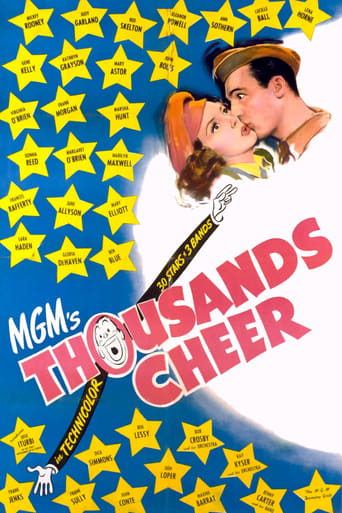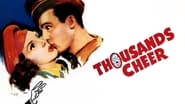MartinHafer
Although the production values for "Thousands Cheer" were very, very nice (since it was made by MGM), I thoroughly hated practically every minute of this dreadfully dull film. The plot was thin, the main character VERY unlikable and the variety show was, for the most part, dreadful. In so many ways, you can find better films than this one."Thousands Cheer" is a WWII propaganda film that is part story and part a variety show featuring MGM acts. The star is a very young Gene Kelly. He has just been inducted in the military and spends most of his time complaining and just being unpleasant. For some bizarre reason, the Colonel's daughter (Kathryn Grayson) has fallen for him. But, because he is almost always in trouble and is so troublesome, the relationship seems doomed.In addition to this plot that I could not care less about (mostly because Kelly's character was just unlikable and argumentative), the film had a VERY long sequence that was a variety show of MGM stars supposedly performing for our troops. Mickey Rooney was the emcee and it featured some mostly bland performances by the likes of Frank Morgan, Judy Garland, Red Skelton and Eleanor Powell. These sequences made me a bit mad because similar stuff was done so much better in Warner's "Stage Door Canteen" and "Hollywood Canteen". These similar variety shows intended to entertain and bolster our troops were just much more fun.So it obviously sounds like I didn't like this film--and that is indeed true. The problem is that there were many, many wartime armed services films that were better and there were variety shows that were better. Despite "Thousands Cheer" being in color, it just didn't deliver and was a terrible role for Gene Kelly.
Turfseer
I was fortunate to see this film on the big screen at Lincoln Center and I recommend you do the same if you're able to. Made during World War II, it's a rousing tribute to the armed forces, and it still entertains to this day. The film is really divided into two distinct parts. The first is the romance between Private Eddie Marsh (Gene Kelly) and Kathryn (played by Kathryn Grayson), who is the daughter of Eddie's commanding officer. The second is a musical revue performed in front of the troops, featuring all the big MGM musical and comedy stars of the day.Marsh comes from a family of aerialists, the Flying Corbinos. One of the many highlights in the film are the great circus shots featuring the 'Corbinos' as they perform death defying flying trapeze stunts. I suspect that the 'Corbinos' were a group created just for the movie since I can't find any reference to them outside of their association with the film itself.While the overall plot is a bit hokey, it's unusual for its day, in that Grayson's character, 'Kathryn', is a product of divorced parents. When she hooks up with her Dad, Colonel Bill Jones (expertly played by John Boles), she's seeing him for the first time after living with her mother for many years. The film's subplot, involves Kathryn attempting to bring her estranged parents back together and at film's end, it looks like she's succeeded.As for the romance between Eddie and Kathryn, it's pretty standard stuff. Kathryn is attracted to Eddie because he's the only soldier who doesn't fawn over her. He's too busy wrapped up with a chip on his shoulder, bemoaning the fact that the Army doesn't use his talents as an aerialist and believes he'd be better off in the Air Force. After Kathryn makes it clear that Eddie's the one for her, he sneaks into the Colonel's home so he can be with his beloved and ends up being called to the Colonel's office for a dressing down. Instead of ending up in the brig, the Colonel lets him off with a slap on the wrist (extra chores)—after the two switch roles, with Eddie pretending he's the Colonel and the Colonel adopting the role of the beleaguered private. Eventually Eddie must learn a lesson about being a good team player (after leaving his post) and this time really ends up in the brig (something must have been lost on the cutting room floor, since Eddie's transgression, when he leaves his post, is only depicted in its aftermath—we never see where he goes after he disappears).If the rather tame plot doesn't hook you in, there's more than enough entertainment provided featuring the fantastic coloratura soprano voice of Kathryn Grayson and Gene Kelly's phenomenal dancing (his bit with the broom is classic Gene Kelly!). There's also the added bonus of the film debut of film conductor/pianist, José Iturbi, who does some sensational piano playing and conducting. Watch when he accompanies Judy Garland in the second half, breaking into some boogie woogie after she exhorts him to get into the 'groove'.The Eddie-Kathryn story is interrupted in the film's second half with the introduction of MGM's cavalcade of stars. I got a real kick out of seeing how young some of the stars looked back then including Mickey Rooney, Red Skelton and Lucille Ball. Rooney is the master of ceremonies introducing all the acts and does some neat impersonations himself of a very amusing interaction between Clark Gable and Lionel Barrymore. Some of the performers, who were extremely big in their day, are now forgotten to a modern audience. We get a fascinating glimpse of two in particular: Kay Kyser and his Orchestra, the 'funnyman' band leader and Virginia O'Brien, known to 1940s audiences for her deadpan expression while singing various big band hits of the day.Of the stars I was familiar with, of course Judy Garland steals the show with her numbers with Iturbi. And then there's Red Skelton who I used to watch as a kid on TV. He's enjoyably goofy doing one of his slapstick routines. Also of note is Frank Morgan (The Wizard of Oz) who plays a lecherous physician, 'examining' various starlets who come by to see him in his physician's office (one of those starlets is a very young Lucille Ball). Eleanor Powell is also particularly impressive doing a tap routine and the very cute child actress, Margaret O'Brien, shows up, who was almost as popular in the 1940s as Shirley Temple was back in the 30s. Also look for a pre-'It's a Wonderful Life' Donna Reed in a short cameo. Finally, I was heartened to see some black performers featured in the film despite the fact that the armed forces were segregated during World War II. Lena Horne's rendition of 'Honeysuckle Rose' is thrilling along with accompaniment by extremely accomplished black big band performers.'Thousands Cheer' wraps up with Grayson leading the United Nations Chorus singing a song called 'United Nations', a powerful (but not very tuneful) piece, predating the establishment of the United Nations itself in 1945.'Thousands Cheer' served its purpose of cheering up the troops and the general public during World War II. While the basic plot can be described as 'fluff', the level of talent here is unprecedented and you will not only find it very highly entertaining but a fascinating glimpse at a bygone era.
David Allen
Thousands Cheer (1943) starring Gene Kelly was made using the very best of MGM's actor and movie technician talent in color, and is well done in those areas. I never saw Kelly do such a good job acting, and the same is true for his co-star, Katherine Grayson. Other major actors part of the movie all do well, including Mary Astor, Mickey Rooney, and Judy Garland. It's a spectacular movie technically, and quite a showcase for good actor movie star work done well and skillfully, a credit to all who appear in front of the camera and worked on the machines behind the screen. But there is no script worth the name, and not a single good song appears in this movie, which is supposed to be (and is) a "musical." Judy Garland does her best at the end of the movie with a mediocre song, even though she's always worth seeing. One of the true saints of world cinema history. The movie is an embarrassment of riches except for the bad (non-existent) script and the lack of a single good, memorable song. And this from the then biggest and richest movie studio in the world, MGM. It's an oddity worth seeing for its display of talent, unconnected as that turns out to be with good writing and good song composition. The color especially is dazzling. It's an upbeat "crowd-pleaser" movie needed and delivered during the World War II years. But the lack of good writing and good songs makes it mediocre.
dallen775
OK Plot begins to bog down, then gets completely interrupted by a parade of stars, some of them annoying, some great. Highlight of stars is Judy singing, Mickey's impressions and Eleanor Powell seen in color. Highlight of movie is Gene Kelly's only dance number (the famous one with the mop). Really good actress Mary Astor is once again wasted.




